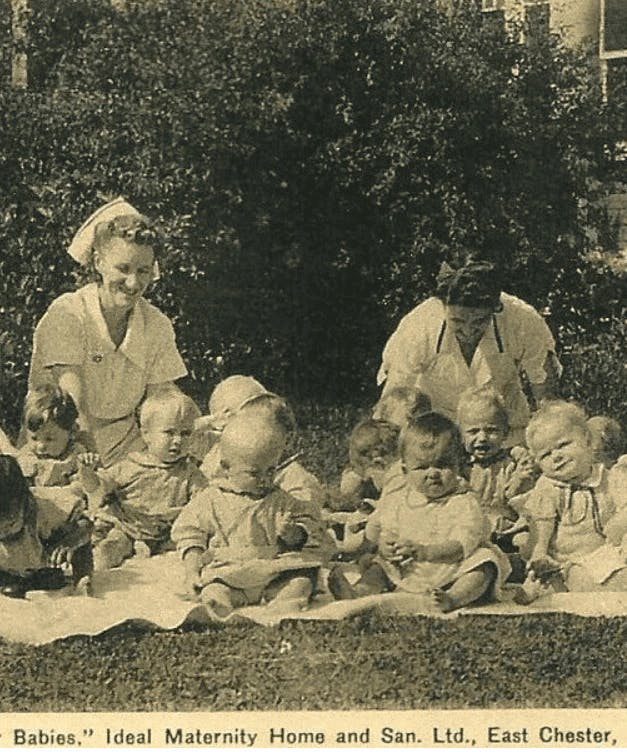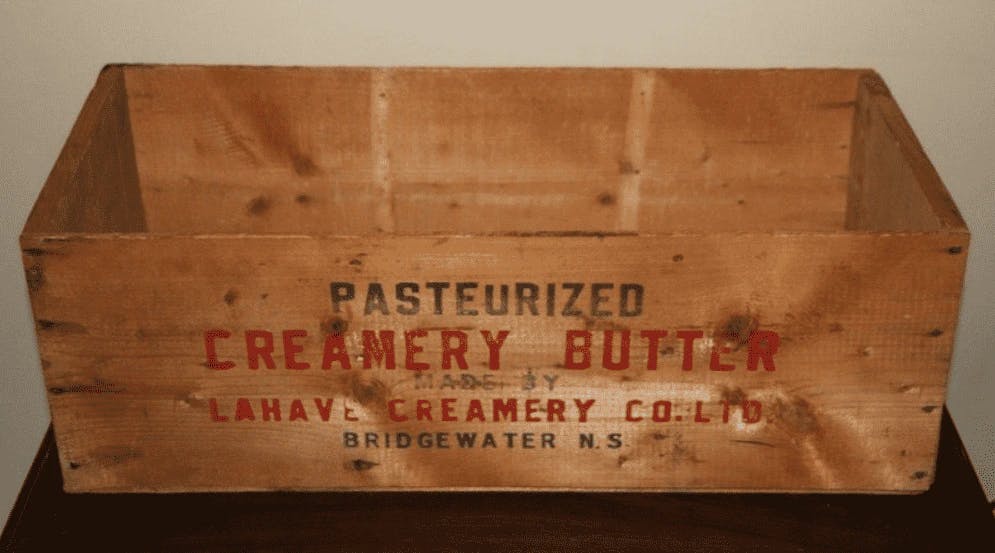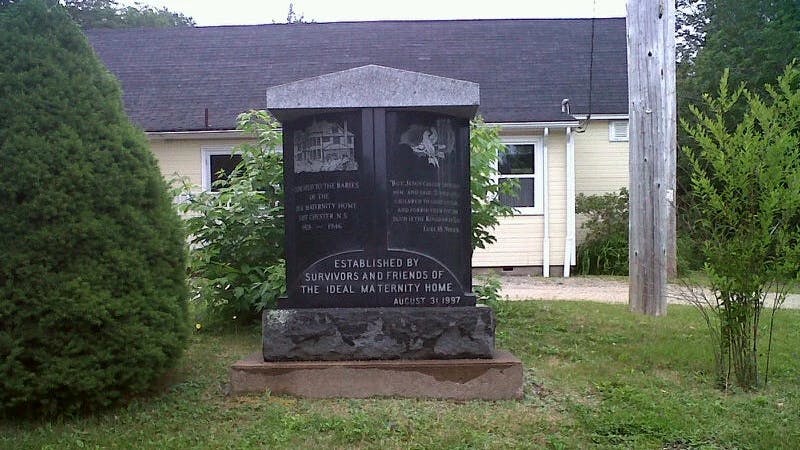The Butterbox Babies: The Stolen Babies Of Nova Scotia
The mysterious tragedy of the Butterbox Babies is a story of deceit, greed, and murder. Even now, nearly 100 years later, what happened at the Ideal Maternity Home in East Chester, Nova Scotia still horrifies and baffles historians and the descendants of those involved.

Article updated with corrections supplied by Riva Barnett 07/29/2022.
The Ideal Maternity Home
Lila and William Young opened the Ideal Maternity Home in the 1920s. He was a chiropractor, and she became a trusted midwife. Together, they created a place where young married couples, and even unwed mothers, were able to give birth without creating a fuss. The Youngs were very discreet and became “The Baby Barons of East Chester.”
As World War II took its toll on the region, resources were limited, the ports often closed, and young men left behind unmarried mothers or widows. This meant more business for the Youngs, and the home was expanded. It became one of the only places to serve the area and was remodeled to include 54 bedrooms that held around 100 babies in the nursery at any given time.
But as this business grew more lucrative, the Youngs focused less on health care and more on profits. They charged mothers between $300 and $500. The average week’s wages were only $8 at the time, and so many of the new mothers had to work in the home to pay off their debt.
The Youngs found other ways to line their pockets. In the United States, adoption across religions was not allowed. Only Christian families could legally adopt Christian babies, Jewish families were limited to Jewish babies, and so on.
On the East coast, a disparity of Jewish couples wishing for a baby but unable to find one of their religion grew, and the Youngs took advantage of this. They used their facility, The Ideal Maternity Home, to illegally provide babies of any background to these adoptive families.
Some couples who went to the home to deliver their baby were told that the child died in birth. Then the healthy, very much alive baby would be adopted out. Unwed mothers were coaxed into giving up their maternal rights, and if they did not wish to, they too were also subjected to the lie that their baby had died, all so the Youngs could turn around and sell each infant for upwards of $10,000. (That price tag is valued at close to $160,000 in today’s money.) The Youngs quickly made a fortune, but it wasn’t enough for them. They continued this practice for years.
Child Trafficking Led to Murder
What’s worse is that the Youngs sometimes found themselves stuck caring for what they considered “unmarketable” babies. They couldn’t return the infant to the mothers after already declaring death – that would ruin the business – so the Youngs purposefully starved infants they considered “undesirable.” If a child became ill, had deformities, dark spots, or birthmarks, they were often fed a thin diet of molasses and water. This killed the babies within a period of about two weeks.
Why they resorted to this instead of outright murder is curious. Those of us who look for the better aspects of humanity hope that maybe the first few deaths were accidents and that the Youngs just lost control of the situation. Maybe they were mismanaging funds and thought this diet could sustain life until they were able to buy proper formula. It’s possible that they knew what they were doing was wrong and wanted to soften the emotional toll. However, it’s more likely that the Youngs worked to keep up appearances (to appease the mothers working to pay off their debt at the home), and were cruel, hardened individuals who developed a God-complex because of their work.
Some mothers are said to have suspected issues. As the business grew, unsanitary conditions caused illness and conflict. But the women working in the home were either unable to prove wrongdoings or were afraid to expose these crimes because they would then lose the discretion provided by the Youngs and their horrid home.
However this came about, the Youngs began to dispose of the dead bodies by acquiring small wooden grocery boxes, often used for butter and other dairy products. This led to branding the victims as “Butterbox Babies.”
These Butterbox Babies were buried on the property, at Fox Point cemetery, or at sea. As more deaths occurred due to unclean conditions and overflow, babies were even said to be burned in the home’s furnace. There is no way of knowing how many babies died at The Ideal Maternity Home because records were destroyed in a fire in the 1960s. Also, many of the births and subsequent deaths were not reported to local authorities.
Truth, Business, and Legal Action
Public health officials began investigating The Ideal Maternity Home around 1935, but it took years before they could create a case that would stop the Youngs’ activity. In 1945, an inspection showed definite signs of abuse and neglect. Reports of filthy bedding, swarming flies, and squalid conditions were enough for legal action, but the fact that some infants weighed only half the healthy weight for their age raised immediate concerns.
Pediatricians and mothers came forward to testify against the Youngs. They noted that the home was overcrowded and deadly. One mother admitted that her baby died after receiving no medical attention and was buried in a butter box. This same mother admitted that the Youngs coerced her into posing as a nurse during a health department inspection. Another woman opened up about lying on adoption forms and saying that her child was Jewish to cater to the Jewish adoptive parents that the house served.
The Youngs lost their license, and the Ideal Maternity Home was ordered to be shut down in November 1945. Despite this, however, they kept running their operation illegally. By the next spring, they were arraigned on eight counts, which included practicing without a license and violation of the newly created Maternity Boarding House Act – which was likely passed because of facilities like the Ideal Maternity Home.
They were convicted on three counts and fined a mere $150 dollars. This slap on the wrist did nothing to deter them. The Youngs were brought in a year later, on June 5, 1946, and convicted of illegally selling babies to four American couples. Once again, their punishment was a simple fine of $428.90.
Apparently, only fining child traffickers who allegedly murder children was the new protocol. In truth, no one knew how to handle the situation and there was hope that a loss of reputation and societal shunning would aid the court’s decision. The Canadian legal system had yet to understand the depths to which some criminals were willing to go.
The Youngs, again, continued operating their illegal business and were full-in at this point. Whether they truly cared in the beginning and things just got out of hand, or they were cold-hearted monsters from the very start, William became a drunk and Lila refused to adhere to the laws or concern herself with the health and wellbeing of the babies she birthed.
Her own arrogance is what truly brought about the end of the operation. Lila Young grew furious at the Montreal Standard Publishing Company for covering the Ideal Maternity Home’s crimes. She retaliated at the bad publicity by filing a $25,000 libel suit. This led to further investigations that exposed every detail, all the way down to the babies buried on the property.
The libel suit was dismissed by the courts. This left the Youngs bankrupt. They had to sell off their property and move away.
Child welfare authorities in Canada and America were so concerned with what the Youngs had done that they developed new laws to protect adopted children. The Youngs had been able to operate within legal loopholes and avoid jail time due to circumstantial legalities of the time. No one could fully prove that the dead babies had been murdered, only that most died of illness or starvation – perhaps this is why the Youngs used starvation as their preferred method of murder.
Both Lila and William died in the 1960s. The house itself was scheduled to be converted into a resort hotel, but that wasn’t to be. The home burned down in September 1962, hopefully cleansing the land of all the pain and suffering that took place upon it.
The Survivors' Stories
For decades, the Butterbox Baby Survivors searched for the truth of their lineage. In 1997, a group of the survivors came together to host a memorial on the grounds of what was once the Ideal Maternity Home.
Ilene Steinhauer admitted that she felt connected to others like her. "We feel related. It's somebody who has lived your whole story."
Another survivor, Riva Barnett, when first learning of her adoption, was told that she was “chosen.” Barnett later came to understand that her mother was drawn to her because she looked sick and unhealthy. A pediatrician in Halifax named Dr. Barrie Coward urged her mother to “get the child out of there as quickly as possible.”
"I realize I could have been bound for a butter box," Barnett said, "and I'm here to tell the story."
Sandy Tuckerman had a similar story. She admitted that her mother told her she was chosen because she had pneumonia and had dark hair and eyes like hers. "If I had stayed there, I probably wouldn't have made it," Tuckerman said. "The sick babies weren't marketable. I feel very lucky that I was adopted."
Barnett was so deeply affected by the truth of her past that she sought out a butter box. She searched antique shops in Nova Scotia when arriving for the reunion. "It's a reminder of where I could have ended up, how I did end up, and it makes me very grateful," she said. She found one (pictured below) and has kept it in her bedroom closet where she can "see it every morning and reflect on my blessings."

Riva Barnett's butter box, like the ones used to bury the babies at Ideal Maternity Home.
Barnett’s adoptive mother also stated that she chose her because of concerns for her health. Knowing this, Riva Barnett got involved in the now defunct website, Survivors of the Ideal Maternity Home, answering questions. Currently, there is a Facebook page about the survivors run by Sharon Knight.
She did eventually find her biological parents, but neither were enthused to hear from her. Her birth father denied paternity. “It's difficult for someone who's not an adoptee to understand the hole. There's just a part of you who's missing," Barnett said. "I wanted to find out where I fit, and it was just a matter of piecing together all of the parts of the puzzle."
A New Connection
For others, that puzzle may not fit perfectly, but new connections are born from this long mystery. In 1999, Violet Eisenhauer had the remains of her daughter – who supposedly died in childbirth at the Ideal Maternity House – examined. Knowing the history of the home, Violet believed her daughter still lived.
“My baby is alive. She didn’t die,” Violet stated. “She was stolen.”
She remembered her daughter well. Born on July 7, 1940, Faith Lu Tanya had deep brown eyes and a whiff of curly black hair. She weighed 8 pounds and 6 ounces. Eisenhauer remembered her baby’s hands the most because they had strange unbroken lifelines that curved the length of her little palms.
“She was all rosy, not wrinkled like other babies,” Violet recounted. “Everyone said she was the prettiest baby there.”

Butterbox Baby Survivors Memorial, via Wikimedia Commons
Violet went to the Ideal Maternity Home because it was the closest to her home. She was a married woman who loved her baby. Even at the time of her birth, the Youngs were under investigation. “I didn’t think to question it,” Violet said. “Why should I think anyone would take my baby?”
The loss of her daughter was so painful that she never had any other children. When she finally decided to have the remains tested six decades later, there was no viable DNA to use.
Still, she continued her search at 78 years old. From what is recorded, her daughter was never found, but she was contacted by a woman hoping to find her mother. A Butterbox Baby survivor, she longed to meet Violet even though the birth date didn’t match up.
Violet found comfort in this and agreed to meet her. “She’s looking and I’m looking,” Violet said. “We’ve both got nobody. We might as well pretend.”
Closing Thoughts
The Youngs not only deliberately killed numerous babies at their Ideal Maternity Home, but they also inflicted decades of pain and separation on mothers and children. Canadian laws were re-examined and updated to deter others from running such an operation, but as we all know, illegal trades and human trafficking still plague areas everywhere.
Despite all of this, the survivors were able to come together and host their memorial for all who were harmed by the Youngs at their horrid home. The Butterbox Baby Survivors’ ability to support each other, and come to terms with this dark spot in history, proves that people have the power to overcome anything – even being robbed of their own family.
We want to know what you think about Evie! Take the official Evie reader survey.